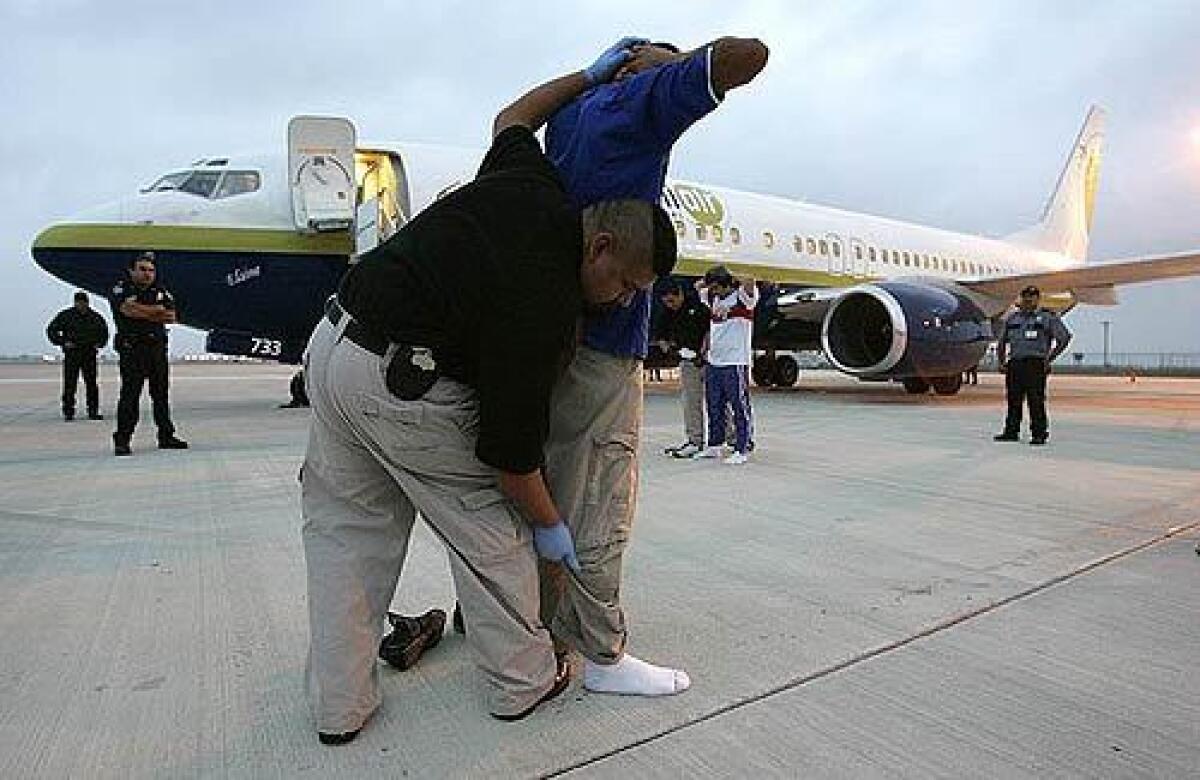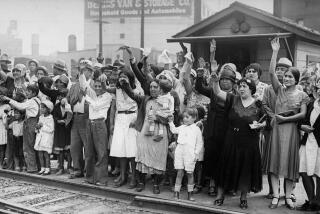Deportee torn between two countries

Henry Fuentes closes his eyes and tries to sleep. But he can’t. He is restless. He looks out the airplane window. This may be the last time he sees the United States. In less than three hours, he will land in El Salvador, a country he hasn’t seen in eight years.
Fuentes hadn’t planned on returning.
Immigration agents arrested him at his Houston apartment last month. Now the government was flying him and 115 other illegal immigrants back to Central America. Some had just crossed the border. Others, like Fuentes, had spent years in the United States and held jobs, owned cars and started families.
Like Fuentes, most of the deportees have mixed feelings about being sent home. They are angry about being deported but relieved to be out of detention. They are excited to return to their roots but frustrated by the country’s lack of work. They are anxious to be reunited with relatives in El Salvador but distraught about leaving spouses and children behind in the U.S.
“It’s very, very hard for me,” Fuentes said as he leaned his head back against the seat. “I feel bad, very bad. I feel happiness because I am going to see my children again. I haven’t seen them in eight years. But I feel sadness because I left my children behind.”
The federal government has stepped up its immigration enforcement in recent years, resulting in record numbers of detainees. Authorities are trying to free up bed space by deporting illegal immigrants quickly and efficiently.
Their primary tool is a fleet of planes used to send home nearly 72,000 illegal immigrants, including about 14,100 criminals, to Central and South America in the 2007 fiscal year. That compares with 50,000 immigrants, including about 9,600 criminals, removed the year before. Authorities said they plan to arrest, detain and deport even more illegal immigrants this year.
The government has ended the practice of “catch and release” and instead is focused on “catch and return,” said Michael Pitts, chief of the flight operations unit for U.S. Immigration and Customs Enforcement.
“It’s a one-way airline,” Pitts said.
Fuentes’ journey began late on the night of Feb. 19 at a detention center in Willacy, Texas, when guards told him he was being deported. Early the next morning, Fuentes boarded a bus.
About 7 a.m., his bus pulled alongside a Boeing 737 parked at an otherwise empty airstrip in Harlingen, Texas. ICE Agent Josie Alvarado came aboard, holding a red pen and a clipboard.
“Good morning,” she said loudly in Spanish. “You are going to El Salvador. When you get off, put your hands on your head. When we are on the plane, respect the authorities, and we will respect you.”
No convicted criminals or gang members were on the flight. They are deported separately.
These deportees get some sympathy from the immigration agents. “We don’t treat them as criminals. We treat them as compassionate as we can,” Frank Filippone, the ICE officer in charge during the flight, said before leaving Texas. “They are here to make a better life for themselves or to send money back.”
That’s what motivated Fuentes to leave his family and pay a smuggler $6,500 for the months-long and dangerous trip north through Guatemala and Mexico and across the border. He had divorced his wife and spent his savings fighting for custody of his two children, Denisse, 3, and Harold, 2. He won, put them in the care of his parents, and went north to earn money to support them.
In Texas, Fuentes worked as a machinist, earning about $100 a day. Each month, he sent home about $500. “I want my children to be professionals,” he said. “Earning $5 a day in my country, I couldn’t do that. That’s why I came.”
But a few years after settling in Houston, he met and married a Colombian woman who has a green card as a legal U.S. resident. Fuentes became stepfather to her daughter, Natalie, and the couple had a son, Sebastian. Both children are U.S. citizens by birth.
For several years, Fuentes had temporary legal status that was granted to many Salvadorans. But on the morning of Jan. 10, immigration agents showed up at his door. They told him he had a deportation order for failing to appear at an immigration court hearing in 2006. Fuentes told them he had moved and never received the notice.
“I always tried to be responsible, very responsible in my life, you know, because I have children,” he said as he sat aboard the flight.
Yet now, he sat aboard the government flight back to El Salvador, with a bag lunch of orange juice, a bologna sandwich and potato chips on the tray table in front of him.
“They say I’m illegal,” he said. “What can I do?”
Many of the immigrants around him had never flown before. They looked out the windows anxiously, fumbled to get their seat belts fastened and gasped any time the plane hit turbulence. A few received Dramamine to quell motion sickness.
There are regularly scheduled ICE deportation flights every weekday to Central America, and the U.S. government has also flown immigrants home to Nigeria, Cuba, Thailand, Cambodia and the Philippines. Tens of thousands of Mexicans are flown to the border and walk back into their country. The cost of the deportation flights jumped from $96 million in the 2007 fiscal year to $135 million this fiscal year. That works out to just over $600 per deportee. Because detaining an immigrant costs nearly $100 a day, Pitts said, “it’s more effective for us to expeditiously get them out of the country.”
As the plane touched down in El Salvador, several passengers applauded and cheered.
Then, one by one, they walked down the stairs. One passenger kissed his hand and touched it to the ground. Another shouted, “Ay, el calor” -- Oh, the heat.
Salvadoran police guided them into a cramped room, where Fuentes and the others sat in plastic chairs and ate plates of pupusas and salsa.
Carlos Rivas, assistant chief of repatriation for the Salvadoran government, told them they would talk to a migration officer and undergo a criminal check. Then they would receive their personal property and could go home.
When Fuentes’ name was called, he walked into an office and sat down at a desk.
“Is this the first time you have been deported?” a woman asked him.
“Yes.”
“Where are you going?”
“San Salvador. I don’t know the address, I only know the neighborhood.”
“What are you going to do here? Are you going to try to return?”
“I don’t know. I have work here, in jewelry.”
Fuentes walked into another office, where a woman sat with a locked metal box full of $1 bills for bus rides home.
“Is your family coming to pick you up?”
“They are coming for me, but if you want to give me money, that’s not a problem,” he said with a smile.
Outside the airport, Fuentes waited on the curb, holding a plastic bag with his letters, pictures and watch. He pulled out the photographs of his wife and children in Houston and read a letter his 10-year-old stepdaughter sent him while he was in detention, signed “La princesa de papa” -- dad’s princess.
“I love you, I don’t want to cry, because it hurts when I do,” she wrote. “If you go to El Salvador, say hi to all of your family. I am going to send you a picture I made for you.”
When Fuentes looked up, his parents were standing in front of him.
“Welcome home,” his father said.
Tears rolled down his face and he stood up, smiled broadly and hugged them each tightly.
“I love you, Papi,” he said in English, and then, catching himself, repeated in Spanish. “Oh man! I missed you so much.”
His father reintroduced him to his son, Harold, 10, who was just a toddler when Fuentes left for the United States.
“How big you are!” he said, lifting Harold off the ground and spinning him around. “Give me a kiss. You’re so handsome!”
Fuentes hopped in the back of a red pickup truck for the bumpy ride home to his house in a neighborhood called “The Mexicans.” On the front door, his children had posted a handwritten sign saying: “Welcome Home.” Inside, they had taped balloons to the walls. Four nieces and nephews he had never met came running out of the concrete, graffiti-covered house.
His 11-year-old daughter, Denisse, who was so little when her father left for the U.S., walked out of the house with a nervous smile on her face. She stood nearly as tall as him.
“How are you my daughter, my precious?” Fuentes said before taking her into his arms. She buried her head in his shoulder. But when her grandmother told her to give him a kiss, she turned her head shyly.
“I understand,” Fuentes said. “It’s been a long time.”
His mother, Maria Lidia Zometa, said she never wanted her son to go.
“With pain in my soul, I had to accept that he was leaving,” she said. “I have him here again. I don’t want him to go back.”
But Zometa said she also doesn’t know what the family is going to do without the money he sent home. Since Fuentes was arrested, the family has already felt the pinch. The house was filled with furniture purchased with money from Fuentes -- a dining room table, couches, a television and a washing machine.
Fuentes’ father owns a jewelry shop, but gang members have robbed him three times. To help out with the bills, his mother borrowed money to start a small store in front of their house. There, she sells diapers, eggs, sodas, chips and napkins.
“These months have been difficult,” Zometa said. “I have seven grandchildren to support. It’s not easy. . . . Life is expensive here.”
After a long night of telling stories, dancing and eating food from the popular Pollo Campero, Fuentes woke at 9 a.m. and walked five blocks to his father’s shop. Working, he said, would take his mind off of what happened to him and the decisions he had to make.
He wants to stay in El Salvador and make up lost time with Harold and Denisse. But he also can’t imagine living without his wife and children. Texas feels more like home now than San Salvador. Maybe his wife and Natalie and Sebastian could join him here while he saves money for the journey.
“I’ll go back because I love USA,” he said. “They don’t love me, but I love USA.”
Times special correspondent Alex Renderos contributed to this report.
72,000 Illegal immigrants sent home by plane to Central and South America in the 2007 fiscal year.50,000 Sent home by plane in the 2006 fiscal year.23,700 Criminals flown home to Central and South America in both years combined.Source: Immigration and Customs Enforcement
More to Read
Sign up for Essential California
The most important California stories and recommendations in your inbox every morning.
You may occasionally receive promotional content from the Los Angeles Times.










